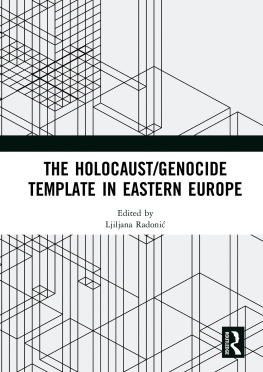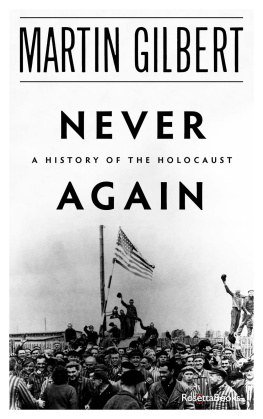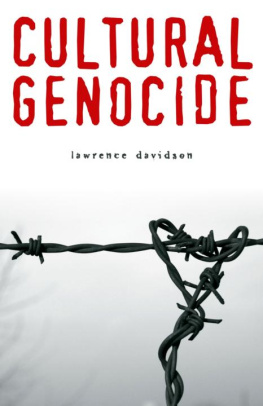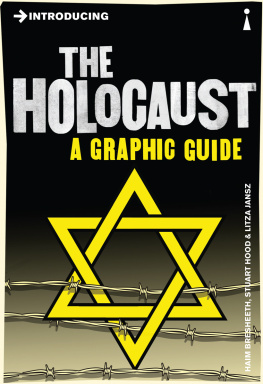HOLOCAUST IMAGES AND
PICTURING CATASTROPHE
To Fin
and the ties of this earth
Holocaust Images and
Picturing Catastrophe
The Cultural Politics of Seeing
ANGI BUETTNER
Victoria University of Wellington, New Zealand
First published 2011 by Ashgate Publishing
Published 2016 by Routledge
2 Park Square, Milton Park, Abingdon, Oxon OX14 4RN
711 Third Avenue, New York, NY 10017, USA
Routledge is an imprint of the Taylor & Francis Group, an informa business
Copyright 2011 Angi Buettner
Angi Buettner has asserted her right under the Copyright, Designs and Patents Act, 1988, to be identified as the author of this work.
All rights reserved. No part of this book may be reprinted or reproduced or utilised in any form or by any electronic, mechanical, or other means, now known or hereafter invented, including photocopying and recording, or in any information storage or retrieval s ystem, without permission in writing from the publishers.
Notice:
Product or corporate names may be trademarks or registered trademarks, and are used only for identification and explanation without intent to infringe.
British Library Cataloguing in Publication Data
Buettner, Angi.
Holocaust images and picturing catastrophe : the cultural
politics of seeing.
1. Holocaust, Jewish (1939-1945)--Historiography.
2. Genocide in mass media.
I. Title
940.5318072-dc22
Library of Congress Cataloging-in-Publication Data
Buettner, Angi.
Holocaust images and picturing catastrophe : the cultural politics of seeing / by Angi Buettner.
p. cm.
Includes bibliographical references and index.
1. Holocaust, Jewish (1939-1945), and art. 2. Genocide in art. 3.
Political violence in art. 4. Art--Moral and ethical aspects. 5.
Genocide--Psychological aspects. I. Title.
N72.H63B88 2011
704.9499405318--dc23
2011016477
ISBN 9781409407652 (hbk)
Contents
Introduction:
Aftermaths and the Afterlife of Images
Never Again:
Rwanda, Genocide, and the Holocaust
Leaving History Behind:
Memorials and the Dead of Genocide
Representation and Retrieval:
Genocide and the Image of Dead Bodies
Leaving Victims Behind:
Animal Rights, Environmental Catastrophe, and the Limits of the Holocaust
The Act of Looking:
Suffering, the Search for Explanations, and the Image as Accusation
Writing a book about representations of suffering and the catastrophes in our world has been more than merely an intellectually challenging experience. All the more thanks go to those who have accompanied me in it, professionally and personally.
My thanks for their intellectual generosity go to Peter Cryle, Ross Chambers, Jon Stratton, Graham Huggan, and Helen Tiffin; but particularly to Graeme Turner and Tony Schirato, who have been professional mentors, extraordinary colleagues, and generous friends. Many thanks also to Neil Jordan at Ashgate for making writing and publishing this book a very good experience.
And my thanks for their generous friendships, for offering a home for a traveller, and for taking care of body and mind to Bill Main, Peta Mitchell, Femke Koene, Joannes Boele van Hensbroek and Carole Wilson.
The most special thanks to my Australian family, for keeping me grounded and laughing: Kylie Cardell and the whole clan, Michelle Riedlinger, Judy Powell, Peter Riedlinger, and Fin and Tuhi.
Chapter 1
Introduction:
Aftermaths and the Afterlife of Images
In the aftermath of catastrophic events societies are faced with complex material realities. Social, political, environmental, economical, and cultural consequences follow suit how to reform society and political identity in the case of genocide, for example; how to deal with the destruction of human life and material infrastructure; how to handle the effects of environmental catastrophes that threaten both human and non-human life; or, how to institutionalise the memory of these events. The struggle with such material questions in the face of extreme events finds a parallel in the struggle to achieve some sort of understanding of these events and their aftermath. This struggle the attempts to come to terms with the events occurs in the representation and signification of catastrophe. Images play a crucial role in this process. Different images and aesthetic sensibilities are mobilised in the wake of catastrophe, and coming to terms with the catastrophe is dialectically linked, in public discourse, with these aesthetic fabrications and formations, which operate at the level of epistemology rather than ontology. Because of this, images have their own forms of afterlife or aftermath. They become iconic and emblematic (the picture of the napalmed girl, for example). They prompt, repeat, resonate, and interpenetrate each other (the raising of the flag at Iwo Jima and the firemen raising the flag on the rubble of the World Trade Centre). Or, as the journalist Philip Gourevitch (2000) put it, they can revisit us, remembered or imagined from various paintings or movies (301). The afterlife of certain images images that implicate an epistemological, moral, or emotional move lies in their power to inflect and crystallise explanations of what the world is like.
This book is concerned with the politics of seeing: the gaze at catastrophe and the aesthetics of catastrophe. It addresses the political and cultural issues surrounding the representation of catastrophic events, such as the politics of memory and apologies for past crimes. In order to do so, it focuses on one particular set of images used to represent catastrophe: Holocaust imagery that is used for events and purposes other than those directly concerned with the Jewish genocide.
Holocaust Images and Picturing Catastrophe analyses uses of the Holocaust in the pictorial culture of the media and the public sphere generally. It looks at the instances in which uses of the Holocaust come loose from their historical moorings: when a Holocaust transfer occurs. Instances in which this transference occurs are when in Rwanda the Holocaust is invoked to make a case that the mass killings of Tutsis by Hutus were in fact genocide; or when activists and philosophers talk of the suffering animals experience in human culture (in food production or animal experiments) as equivalent to the horrors of the Third Reich, in order to make a case for animal rights. Such transference of Holocaust imagery to other events is the books central concern, and its chapters accumulate evidence from a range of case studies, at various moments of time and in various cultural locations, that show the development of this transference across space and time. The case studies are chosen from the variety of areas that need to be examined in the context of the re-usage of the Holocaust. They range from incidents close to the Judeocide to incidents removed further and further from their specific historical referent (the Israeli-Palestinian conflict, Rwanda and other genocides, terror and violence more generally). The books central argument is that the Holocaust has become a benchmark against which other events are judged, and that Holocaust imagery is resurfacing everywhere, in political and legal discourses, in critical thinking and philosophy, as well as in popular culture.








